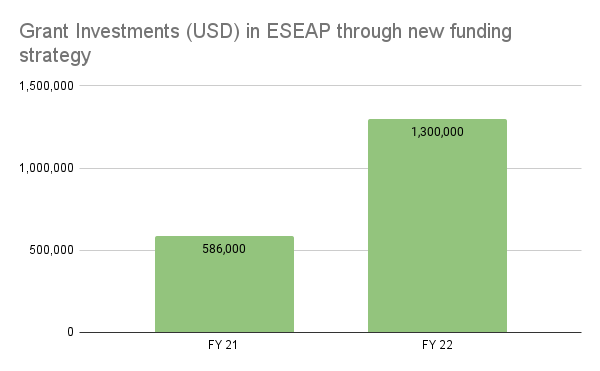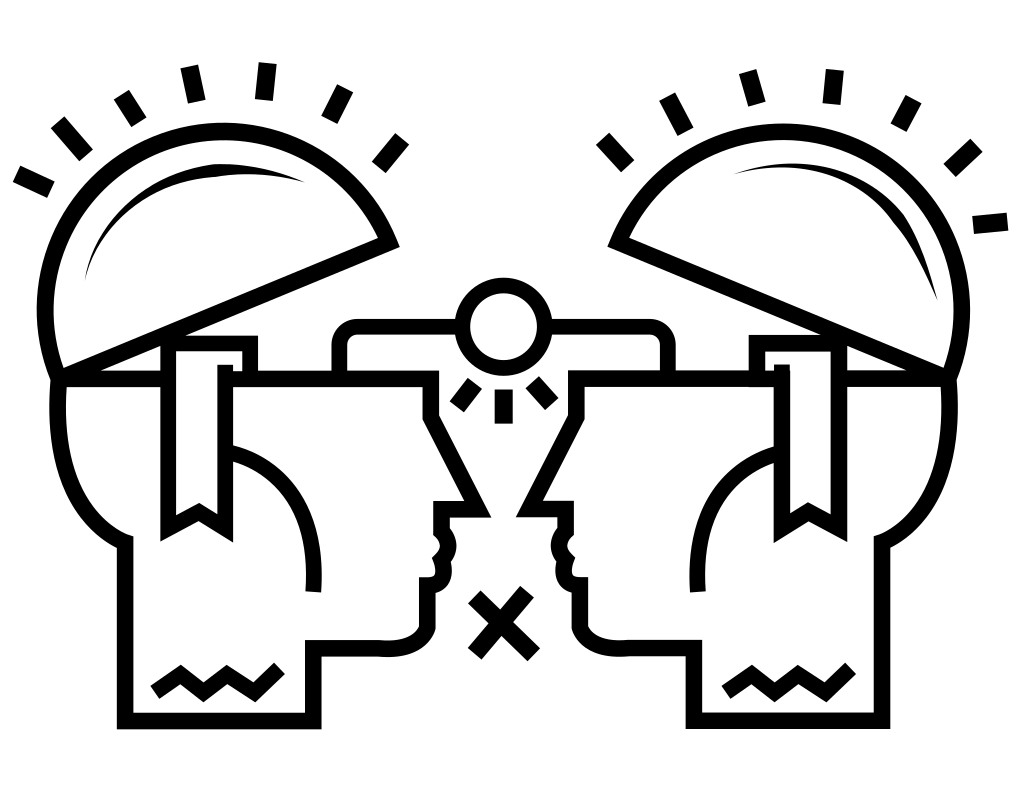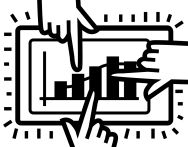A journey of a thousand miles begins with a single step
– Laozi
As the year draws to a close, it’s time we recap some of the impact achieved, the learnings gathered, and the progress made in the ESEAP region (East Asia, South-East Asia, and the Pacific) under the new funding strategy.
Let’s start with some ESEAP-level statistics
33 geographies are grouped under the ESEAP Region. Our movement has 13 affiliates based in the region – 5 chapters and 8 user groups- and the many volunteers who may not be affiliated are active and regularly contribute to furthering our movement’s mission.
ESEAP as a region contributes 16.6% of the global readership traffic (12 month average), with 33 billion unique views across all projects. Its share of unique global editors is 15.4%.

Between July 2021 and June 2022, the region received 11% of global funding (up from 7% in the previous year); this is a 135% increase from the previous year (USD 586,000 to USD 1.3 million), 94% of the total investments were directed to emerging communities. 77% (10/13) of recognized and active ESEAP affiliates have applied for and were awarded funding, with more in the pipeline in the coming months.
The new funding strategy is an iterative process that will continue to grow and evolve with each round of applications, implementation, and reflection – we need to be agile to provide proactive support to our growing movement in ESEAP. This is our collective effort.
So, here are 8 highlights of our movement’s remarkable achievements in the region. We need your support to take our work to the next level and want to work with you to create a welcoming and enabling environment for existing and future grantees. So, let’s continue reading!
1. Diversity in the Regional Funds Committee

We increased our committee members to 12; these members bring together a diverse, experienced, and community-focused mindset to the committee. These members are committed to the movement and have been contributing by editing, organizing, or lending other forms of support to the communities. We have people who have worked with the youth (an essential demographic of ESEAP), research, partnerships, and underrepresented groups (LGBTQI+)
Following the Wikipedia Education Program from Wikimania London in 2014, there was a u-turn on the community’s stance about students submitting their homework to Wikipedia. Pilot classes were conducted at Mahidol University and it was an opportunity to grow the volunteer base that turned out to be the backbone of Wikimedia Thailand today.
Taweetham Limpanuparb (Taweetham), Member of ESEAP Funds Committee, Long-time volunteer from Thai Wikipedia
2. Increase in first time applications (more are welcomed!)
We saw an increase in new applicants globally, and ESEAP stood 2nd in the highest number of grants given to first-time applicants. Our new funding structure has diversified and enabled easy entry points for new grantees. Hence we saw 13 first-time applicants in the region.
To find out more about our funding process and the changes, get in touch with us (via eseap_fund@wikimedia.org)

3. Small and Everyday Wins pave the way for lasting impact and a growing legacy
Some of the fantastic impact in the region;
- Wikimedia Korea: Completed the first strategic planning exercise with Board members and welcomed diverse audiences into the movement with specific focus on socioeconomic, youth, gender, and neuro-diversity;
- Wikimedia Taiwan: Developed a robust open-access culture and close partnerships with Government and civil society organizations. Provided a supportive environment for indigenous local knowledge/ language Wikipedia/ communities to grow;
- Wikimedia Community User Group Malaysia: Successfully opened their formal bank account to receive grant funding as an affiliate;
- Wikimedia Australia: Produced a three-year strategic and a detailed activity plan while securing multi-year funding. Australia is set to host the 2022 ESEAP conference Sydney in November, the first gathering for the region since 2019;
- Aotearoa | New Zealand User Group: Set up a working committee, completed strategic planning, successfully applied for first grant funding as a user group, and started the process to apply for non-profit status, all in 12 months;
- Wikimedia Thailand: Bringing the Thai editing community closer together, more engagements with youth led- and focused approach;
- Wikimedia Community User Group Hong Kong: Successfully applied for their first grant and built skill sets in planning, and budgeting, while being youth-led;
- Wikimedia Indonesia: Underwent a leadership renewal process, building and supporting new local Wikimedia communities, and made space for more volunteers to move from local to regional participation and representation
As our user group completes our third year of existence it’s inspiring to see the growing number of editors putting time into organizing events and projects. We’re changing from a group of individual editors into a community supporting one another with a diverse range of initiatives. The operating grant has accelerated this rate of change.
Victoria Leachman, President, Wikimedia User Group of Aotearoa New Zealand
4. Increased focus on Partnerships through the Wikimedia Alliance Fund
Through the Wikimedia Alliance Fund, which supports mission-aligned organizations that are underrepresented in our movement, the ESEAP region welcomed 6 partners who are piloting new approaches to bring in more diverse content, contributors, and consumers of Wikimedia project content. These partners are crucial to establishing accelerated growth of the movement in ESEAP. For example, Analysis Policy Observatory (Australia); Creative Commons (Indonesia), Open Street Map (Indonesia), National Cheng Kung University (Taiwan), Open Street Map (Taiwan), Shin Leh Yuan Art Space (Taiwan)

The ESEAP region and Wikimedia Funding Programme have come a long way. While we are celebrating the success in the region, a lot of work is waiting to fill the gap in knowledge equity – including creating access to countries without representation yet.
Kartika Sari Henry (22Kartika), Member of ESEAP Funds Committee, Wikimedia Australia and long-time volunteer with Wikimedia Indonesia
5. Emergent trends in our grant applications
Program Delivery and Innovation
Globally, “youth” does not seem to be prioritized in programming. However, in the ESEAP region, youth-focused or youth-led projects are an emerging trend.
There are exciting innovations linked to culture & heritage, such as digital mapping to promote historical infrastructures and strong partnerships with Museums that develop specific projects focused on Wikimedia contributions.
Regional Level Focus
All affiliates expressed interest and intent to contribute and participate more actively at a regional level. Some have included process indicators in their annual work plan on regional collaboration and partnerships, such as New Zealand and Australia affiliates.
Building Movement-wide Capacity
With more flexible funding programs, we see increased demand for skills training for the community, paid staff, and Board members, from facilitation skills to cultural sensitivity training. Community members also have access to peer learning opportunities through Let’s Connect, which seeks to build an inclusive learning culture based on the notion that: we all have something of value to share – given the information to connect, the right spaces, and logistical support.
Growth and Diversification
All affiliates have identified content and representation gaps and are actively working on bridging these gaps on themes such as gender, indigenous communities/ First Nation, and youth. We see a more profound reflection and focus on equity and inclusion
Being a Wikimedia Regional Funds Committee member for ESEAP has been a fulfilling experience for me. It brought me a bigger insight on the unique needs of each applicant affiliate or alliance organization. It gives me delight in being part of the process that brings the wishes of the target community to life.
Butch Bustria (Exec8), Member of ESEAP Funds Committee, Wikimania Steering Committee and Movement Strategy Roles & Responsibilities Working Group.
6. A Multi-lingual approach

12% of grant applications submitted were in a language other than English (i.e., Mandarin, Indonesian, Korean, and Japanese). Many required translation and interpretation support to engage and participate effectively. With the Foundation streamlining and increasing its translation and interpretation support, we will welcome applicants from more diverse geographies (in particular for rapid fund programs)
As a new member of the ESEAP funds committee, reading applications amazed me: in spite of language differences, all of us have the same problems. My aspiration is that communities will share strategies across languages. “Not just inviting partners to inform our thinking, but also letting partners lead us into areas that are outside our comfort zone.”–a key takeaway from my onboarding orientation on the topic of Review Mindset.
Yumiko Shibata (YShibata), ESEAP Funds Committee and part of wikimedia movement in Japan
7. Support beyond Funding: Let’s Connect and regional learning sessions
Building on the Let’s Connect peer learning program, Community Resources hopes to set aside spaces for reflection, connection, and collaboration at a regional level and globally across regional funds committees. In October 2022, we kicked off the inaugural ESEAP learning session, attended by close to 40 participants (the majority are existing grantees from rapid, alliances, and community fund programs). The session was rich in content on regional meta-level trends and provided participants with inputs on contributing to shared learning and localizing trends.

8. Let’s Reconnect- The ESEAP Conference

One of the most significant milestones for our region is the focus of our communities on region-level convening, representation, and strategizing. A perfect example of this outlook is the ESEAP conference, which will be held in Sydney in November with the theme of reconnecting, something that is critical for the region as we emerge from the pandemic. The conference will be a moment for us all to regroup, reconvene and re-energize our strategy as we advance.
The ESEAP Program officer and representatives from the ESEAP Funds Committee will join the conference in person. We are excited to continue our conversations and welcome all to reach out (via eseap_fund@wikimedia.org) if you are interested in knowing more about the process and how we can support you in your planned endeavors.

Can you help us translate this article?
In order for this article to reach as many people as possible we would like your help. Can you translate this article to get the message out?
Start translation

